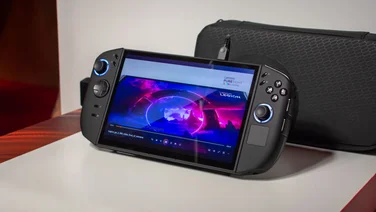To help us provide you with free impartial advice, we may earn a commission if you buy through links on our site. Learn more

Just outside a cave full of bioluminescent rocks and skittering armadillo creatures, my star ship lies in ruins. I’ve only just regained consciousness, but the voice inside my exosuit is already giving me a rundown of my current situation. It wouldn’t be so bad if it was just the launch thrusters that were down, but with my shields and pulse engine also in serious need of repair, I begin to wonder whether I’ll ever get off this strange hunk of rock.
I guess I must have crash-landed, but at least my suit and gun-like multitool are still intact. I’m quickly told that both need to be charged at regular intervals with various isotope injections in order to remain functional, but when a quick glance of my surroundings reveals that almost everything can be broken down into some sort of mineral, basic survival quickly becomes the least of my worries.

Instead, my chief concern is getting my ship back up and running, so I quickly scan my surroundings and set off towards what looks like a large mineral deposit, a small countdown timer on my visor ticking down the seconds until I get there. Inevitably, though, I get side-tracked by a weird rock formation or a rather spectacular-looking six-legged space dinosaur, so that initial journey of mere minutes ends up taking nearly an hour.
And yet, that’s what No Man’s Sky is all about – those small moments of awe and wonder as you jump between planets on your way toward the centre of the universe. You may not ever get there – there are more than 18 quintillion planets here to discover, after all – but that’s okay, because this world of procedurally generated stardust is built to distract and divert, always giving you one more thing to look at in order to pull you over the next horizon.

It’s an incredible feat of engineering, and every planet I’ve discovered thus far has, by and large, given me plenty of reasons to stay beyond the initial, basic story demands. I’ve discovered hundreds of little outposts, met dozens of aliens, learned some of their language, uncovered new technologies for my gun and exosuit, answered distress calls from other downed ships (and even fixed and repaired one to claim it for myself), found abandoned manufacturing facilities and uncovered lost histories of alien civilisations – and that’s all without ever leaving my first galaxy.
It makes for an insatiable opening, but as the hours draw on and star systems start to come and go, those early moments of magic quickly settle into drudging routine. The identi-kit outpost pods all start to blur into one after a while, the facilities you find are either empty or don’t sell the one thing you need in order to complete your next objective, or, as is most often the case, you simply run out of inventory slots in your suit and ship when you’re out gathering materials, forcing you to either discard your hard-won goods or commence the long search for a trade terminal before you can continue. You feel less bitter when you’ve got some nice scenery to look at, but when the fiftieth discovery point you’ve found still doesn’t deliver what you need, even the most outlandish animal discovery won’t lift your spirits.
It wouldn’t be so bad if the cataloguing aspect of No Man’s Sky was a little more satisfying. As long as you’ve got a scanner installed on your multitool, you can sweep your environment for new species and upload them to the all-encompassing Atlas to earn credits. You can even name your discoveries for other players to see – provided, of course, that they also happen upon the same speck of sky that you’ve previously visited.

However, given all the weird and wonderful creations out there (which are also procedurally generated), it’s a shame that you can’t also see what other players have found and compare them to your own. You can also only view your discoveries in the order you found them on each planet, so if you want to view all the animals you’ve seen, for example, you’ll be left disappointed. Each planet also has a list of so-called Records to unlock, but when each one has a nonsensical name with no information on how you even achieved it, it’s not exactly clear what purpose they serve.
You can also forget trying to revisit waypoints you’ve discovered in the past, as the sheer size of each planet and the lack of an in-game map makes it nigh on impossible to find things again, particularly if you come back to a planet after visiting another star in the solar system. Admittedly, having a map for a world that’s procedurally generated is probably a bit of a contradiction in terms, but even a vague indication of which areas you’ve already charted upon entering a planet’s orbit, for example, would have gone a long way to help aid navigation and general time management.

It’s not too much of a problem in the grand scheme of things, as your bulging inventory systems quickly forces you to adopt a ‘take it or leave it’ kind of mentality for the whole game. Never mind that you can’t find that upgrade pod again, there’ll be another one along in 15 minutes or so (maybe). This is fine as long as you enjoy the game’s minute-to-minute grind, but I fear less patient players will begin to grow bored with No Man’s Sky after the initial novelty of bombing around space has worn off.
No Man’s Sky isn’t perfect, then, but that doesn’t make Hello Games’ achievement any less impressive. The team should be applauded for what it’s managed to achieve with such a small team of developers, even if the end result doesn’t quite live up to the game’s pre-launch hype. Its systems may not hold together very well, but there’s plenty to admire in this cosmic playground, and it’s the perfect tonic for those hankering after something a bit more inspiring than the cold, hard science of space games like Elite: Dangerous. At the moment, I don’t feel it has quite enough depth to keep players engaged over long periods of time, but if Hello Games can iron out its kinks, then No Man’s Sky could potentially be one of the greatest space romps of this generation. Right now, though, it still has some way to go before it can truly reach for the stars.







